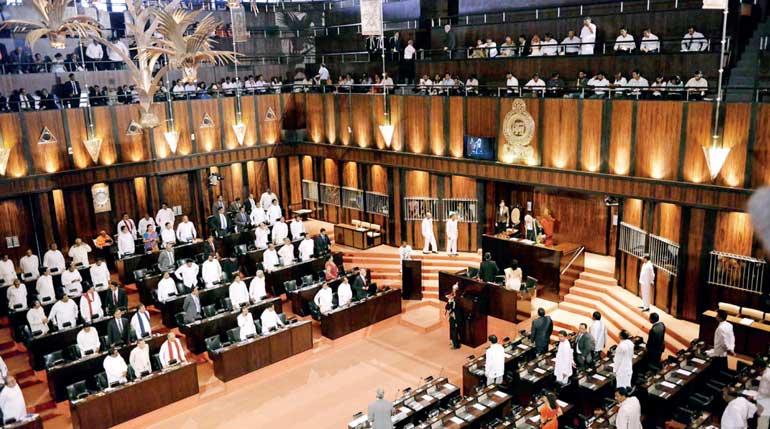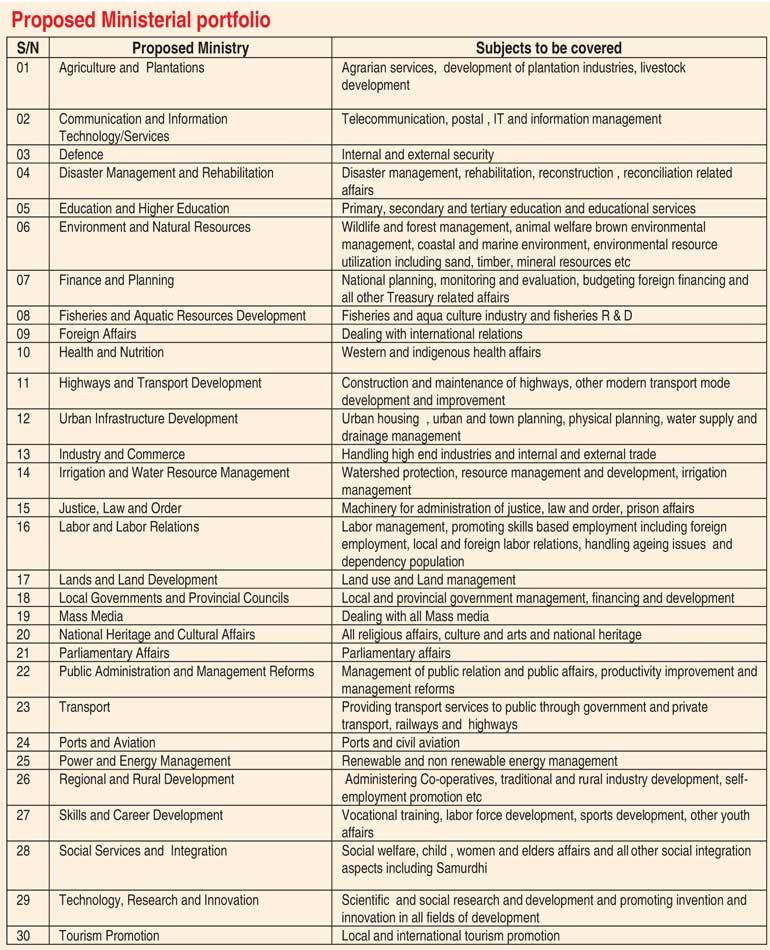Friday Dec 05, 2025
Friday Dec 05, 2025
Thursday, 16 July 2015 00:00 - - {{hitsCtrl.values.hits}}
 Sri Lanka Parliament in session – File Photo
Sri Lanka Parliament in session – File Photo
By Nazeema Uzby
Since the General Election of 2015 has now been declared, the environment is ideal to discuss ministry portfolios that should exist in the country in accordance with the 19th Amendment to the Constitution (19A) which limits the number of Government Ministries to 30.
This reduction is a main feature in 19A and hence the majority of the society, especially the professional community is eagerly awaiting its implementation. It is well known that with each change of Government, ministry portfolios and the public sector institutional mechanisms take a different shape, irrespective of its relevance, integrity or combination. Having a meaningful combination of subjects coming within the purview of each ministry is vital for a sustainable public sector institutional mechanism. An ad-hoc and fragmented ministerial system leads not only to unsustainable policy, program and project implementation, but also to inefficient use of scarce resources. A government that has a focused vision will decide the number of ministries according to its vision – service based, industry based, issue based etc.
Unfortunately in Sri Lanka, very often, a long term vision is not identified and thus there are no priority areas and ministries are decided on the basis of blended ideas and desires. In other words, the individual interests of political leaders become the main criteria for the creation of ministries. Relevance of subjects and functions and its relationship are not given due consideration. A good example of this would be the subject of wildlife conservation where it was once with the Ministry of Public Administration.
However, it is worth mentioning that some of the Ministries that exist within the current system are knowingly or unknowingly driving the country towards promoting our service sectors such as tourism and skilled labour.
If we look at the Indian governmental model, it is a mixed setup which is both industry and issue based. However, the priority industries are defined towards achieving a focused vision. For example, in that nation there are separate ministries to deal with industries relating to SMEs, heavy industries, mines, steel and food processing. This indicates that the Government has decided the priority areas of development and established ministries accordingly. On the other hand it also has ministries to deal with issues such as minority affairs, tribal affairs and human resources development. In Sri Lanka nevertheless, traditional means of promoting the tea, rubber, and coconut and apparel industries have prevailed over a long period of time and none of the industry or service sectors have been prioritised for accelerated development.
Since no priority areas are identified for accelerated economic development, the only approach to establish ministries is largely based on the existing system, but to appropriately assigned subjects and functions under each ministry.
The existence of a ministry in Sri Lanka is justified through the subjects and functions that are assigned to each minister under Article 44(1)(a) of the Constitution by gazette notification. However, when one particular subject or a function that is divided into two portfolios obviously overlaps and thereby there is duplication, the end result would either hinder implementation or lead to inappropriate use of public resources.
Therefore, it is vital that ministry portfolios are defined through a sustainable and cohesive approach so as to deal with subjects and functions which are specific to each area of governance and development.
This article proposes the combination of a ministry portfolio in line with 19A so as to maintain 30 Cabinet Ministries, with special focus on understanding the reality of maintaining the existing political system, while also managing the limited resources available in the country. It should be noted that this proposal is based on the existing situation and that some may propose a completely different approach. I believe that this article will provide at least some guidelines for the establishment of ministries in the next Government and it is hoped that this process will be guided solely through a scientific and cohesive approach.
Rationale for the proposed portfolios
The rationale behind this proposal is primarily based on linkages between related subjects and functions and the importance of having an individual ministry so as to give prominence to national economic development. One might think that some of the ministries are large in size in terms of its subjects and functions, such as in the case of agriculture and plantations or disaster management and rehabilitation. Ministries usually engage in policy formulation and coordination activities while the supporting or implementing agencies under the purview of each ministry will execute the relevant functions. Therefore, one should realise that having more ministries with special focus on projects and programs is not really a requirement in terms of the country’s development.
A good example in this regard would be having a separate ministry for Mahaweli Development. It was a gigantic development project and ideally the activities carried out by that project should have been institutionalised through the existing institutional setup, at the end of the project. Meanwhile, the rationale behind identifying the same ministries as prevailing in the past is to maintain the national and international importance of its functions. However, the subjects are categorised in order to maintain cohesiveness and linkages.
Way forward
With the existing system in the country, the administration and management of the institutional set up basically involves two parties or elements, i.e., ministers and bureaucrats. Invariably, the decisions that are taken by the ministers or the political system of the country are implemented by bureaucrats through different institutionalised mechanisms and systems.
Therefore, a trustworthy nation has a definite and challenging role in selecting the appropriate decision makers who will lead the country towards a focused vision. In the meantime, since it is the bureaucrats who implement decisions, it is essential that capable bureaucrats are identified and appointed to leading positions, if the country is to flourish with a focused vision.
Identifying persons for appointment to senior posts merely on their seniority based on the number of years served in the public service should never be a main criterion for such appointment. Therefore, these two elements should be considered and given the highest priority to ensure a system that is sustainable.

(The author wishes to have comments on this article sent to [email protected])